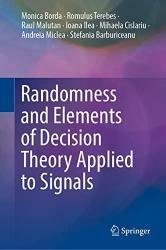 Название: Randomness and Elements of Decision Theory Applied to Signals
Название: Randomness and Elements of Decision Theory Applied to SignalsАвтор: Monica Borda, Romulus Terebes, Raul Malutan
Издательство: Springer
Год: 2021
Страниц: 251
Язык: английский
Формат: pdf (true)
Размер: 11.8 MB
This book offers an overview on the main modern important topics in random variables, random processes, and decision theory for solving real-world problems. After an introduction to concepts of statistics and signals, the book introduces many essential applications to signal processing like denoising, texture classification, histogram equalization, Deep Learning (DL), or feature extraction. The book uses MATLAB algorithms to demonstrate the implementation of the theory to real systems. This makes the contents of the book relevant to students and professionals who need a quick introduction but practical introduction how to deal with random signals and processes
The work, organized in 15 chapters and 3 Appendices, presents the basics of random variables/processesanddecisiontheory,allthesemassivelyillustratedwithexamples, mainly from telecommunications and image processing. The addressability of the book is principally to students in electronics, communications and computer sciences branches, but we think it is very useful to Ph.D. students dealing with applications requiring randomness in many other areas. The whole material has an educational presentation, starting with theoretical backgrounds, followed by simple examples and MATLAB implementation and ending with tasks given to the reader as homework. A short bibliography is available for each chapter.
The difficulty of the material is put in a progressive way, starting with simple examples, and continuing with applications taken from signal and image processing.
Chapter 1, Random variables, introduces random variables and the study of their characteristic functions and values, from both theoretical and practical (MATLAB simulations) points of view.
Chapter 2, Probability distributions, aims to study the probability distributions and the central limit theorem, both theoretically and practically using MATLAB.
Chapter 3, Joint random variables, describes joint random variables and their characteristic functions and values. These elements are theoretically introduced and a MATLAB implementation is available.
Chapter 4, Random processes, describes the random processes theoretically but also practically using MATLAB.
Chapter 5, Pseudo-noise sequences. The purpose of this work is the study of the properties and applications of the Pseudo-Noise Sequences (PNS). MATLAB implementation of a PNS generator is also proposed in the chapter.
Chapter 6, Markov systems, shows several problems and exercises to illustrate the theory of memory sources and Markov chains theory.
Chapter 7, Noise in telecommunication systems. The purpose of this chapter is the study of the noise that appears in communication systems.
...
Chapter 15, Supervised Deep Learning classification algorithms, aims to present the theoretical foundations associated with supervised classification networks of Deep Learning (CNNs), as well as to exemplify their use in data classification applications in MATLAB.
The examples were selected to be as simple as possible, but pointing out the essential aspects of the processing. Some of them are classical, others are taken from the literature, but the majority are original.
Скачать Randomness and Elements of Decision Theory Applied to Signals